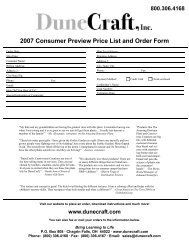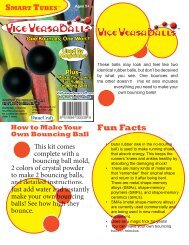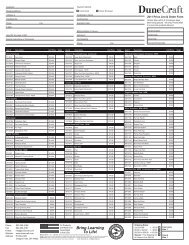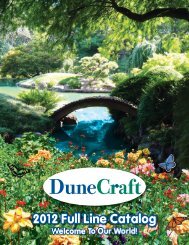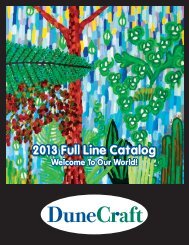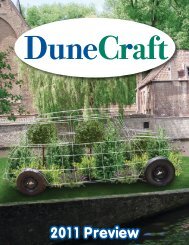Witches - DuneCraft
Witches - DuneCraft
Witches - DuneCraft
Create successful ePaper yourself
Turn your PDF publications into a flip-book with our unique Google optimized e-Paper software.
The pentacle is the most recognized witches’ symbol. It<br />
represents the combination of the mind and spirit and the<br />
mastery of the four elements and is used in many rituals.<br />
St. John’s Wort (Hypericum perforatum)<br />
Plant Information:<br />
St. John’s Wort, also called “scaredevil,”<br />
is one of the oldest known<br />
witches’ herbs. It was traditionally<br />
gathered on Saint John’s Eve to<br />
defend against evil spirits; foliage<br />
would be hung in doors and<br />
windows. The plant was also<br />
burned by people in the middle<br />
ages to repel evil spirits, and it has<br />
long been used in antisorcery<br />
charms. This herb has known to be<br />
magically protective and has been<br />
used to treat melancholy. In fact, in recent times, St. John’s Wort<br />
has been used to treat depression. The red sap that comes from the<br />
stems when the plant is cut has been used externally to treat burns<br />
and inflammation, cure sores, and stop bleeding.<br />
Growing Information:<br />
Sprinkle the seeds on the surface of the soil. They will readily<br />
germinate and grow within a day if given light and moisture. The<br />
variety included in your planting mix is the only St. John’s Wort with<br />
oil glands in the leaves. If you hold a leaf up to the light, you will see<br />
tiny holes in the leaves where the glands are. The only part of this<br />
plant that should be used is the flowering tops.<br />
The Cauldron is from ancient Celtic mythology. The<br />
cauldrons were used for food and in divine inspiration and<br />
intervention rituals. In Celtic mythology, the Cauldron<br />
provides infinite artistic inspiration.<br />
Laying out the Garden<br />
Magical gardens are rarely formal. Most are organized plots<br />
arranged in a circular shape, the circle being the ancient symbol of<br />
fertility, reincarnation, and eternity. Some are quite intricate, laid out<br />
as stars, suns, and crescent moons. Try to position herbs of like<br />
heights next to each other.<br />
Planting<br />
Planting is guided by the moon, as is much of a witch’s life. Some<br />
who follow the movement of the moon through the zodiac will plant<br />
herbs only during the moist and fertile signs.<br />
Gather together the seed packets. Place them just as they are in the<br />
center of the garden. Then taking the seeds, plant them according<br />
to the directions on the package, following the design you laid out.<br />
As you sow each herb place the stake that bares its name facing its<br />
section. As you water your plants, talk to them, use your<br />
imagination, visualize them as they will be when they grow.<br />
Planting Instructions<br />
Growing your garden is easy and rewarding if you follow the simple<br />
steps outlined below.<br />
1. For best results, plan your garden on paper before actually<br />
planting it. Here are some ideas to help add interest:<br />
• Form mounds with the soil and plant seeds on top.<br />
• Make paths by pressing indentations into the soil and filling<br />
with decorative gravel.<br />
• Place the plants in groupings or mix them all together. You can<br />
make several large groupings or many small ones.<br />
2. Apply decals to the base of the dome.<br />
3. Pour about an inch of perlite in the bottom of the planting<br />
container for drainage.<br />
4. Massage the bag of soil, open, and pour to fill the bottom of the<br />
planting base.<br />
5. Mix in one to two cups of water and mix with soil until it is<br />
thoroughly moist.<br />
6. Form paths, mounds, and place stones before planting seeds.<br />
7. Place your seeds on top of the soil and press them in. Here are<br />
some planting tips:<br />
• When planting seeds, place them a third to a half inch apart;<br />
planting them too close together will cause them to crowd<br />
each other out.<br />
• Don’t plant all the seeds at once. Plant what you need, and<br />
save the rest in case you must replant; enough seeds are<br />
included to replant at least one time.<br />
• Be sure to review the content on the seed packet for additional<br />
information<br />
8. Sprinkle about a half cup of water on top of the seeds.<br />
9. Add decorative components and stakes.<br />
10. Place in a windowsill or near a window with an eastern or southern<br />
exposure and in a place where it cannot be easily knocked over.<br />
11. Your seeds will germinate in about a week.<br />
12. Feel free to find your own miniature treasures to add.<br />
13. Retain these instructions for further use.<br />
Growing and Care Tips<br />
Watering<br />
• Your terrarium will only need water every one to three months<br />
when the top is on. You can tell the relative moisture by the weight<br />
of the container. Even if you see moisture forming inside the lid of<br />
the container, the terrarium may still need water.<br />
• If you over-water the terrarium, tip it gently to pour out the extra<br />
water, leave the top off, and place it in an area with a southern<br />
exposure until desired moisture level is reached.<br />
• Your growing mixture is inert and contains no fertilizer. You may<br />
fertilize your terrarium in the spring and summer with a watersoluble<br />
houseplant food or time-release pellets. Your plants prefer<br />
to be fertilized during the spring and summer.<br />
• When you water your plants, sprinkle the water over the foliage to<br />
rinse the leaves.<br />
Location<br />
- Your plants like bright light. Be sure to rotate your dome a quarter<br />
turn to encourage even growth. The best location for your<br />
terrarium is on a windowsill with an eastern exposure. Be sure the<br />
window is not drafty.<br />
- Your plants prefer to be in a cooler room. Many plants will wilt in<br />
direct, hot afternoon sun.<br />
- Your plants will naturally reach toward the light, so rotate your<br />
greenhouse every week. If they are stretching too much, they may<br />
need more light.<br />
- Do not place your terrarium close to a heating or cooling vent.<br />
- Do not place your terrarium outside in the hot sun. The<br />
temperature inside the terrarium will rise to levels that are not safe<br />
for the plants. You may place it outdoors in the shade and when it<br />
is below 80 degrees (26° Celsius).<br />
- Your terrarium is sensitive to temperature and should be in a room<br />
that is between 60 degrees (15° Celsius) and 85 degrees (29° Celsius).<br />
- A common problem with terrariums is that they are easily knocked<br />
over. Keep this in mind as you choose the location for your<br />
windowsill greenhouse.<br />
Other Notes<br />
- If mold forms, remove it with a twig or water the greenhouse with<br />
a 1:50 mix of hydrogen peroxide to water (one capful of hydrogen<br />
peroxide to seven ounces of water). This will kill the mold but not<br />
the plants.<br />
- If you remove the top to allow the plants to grow larger, be sure to<br />
check the moisture level every few days.<br />
- If a particular plant is overgrowing the rest, feel free to trim it back.<br />
- You can trim your plants back if they are growing too wide or tall,<br />
or you would just prefer them bushier. It is important to cut them<br />
above a set of leaves and to water afterward, as pruning can be a<br />
shock to some plants. This will help keep them small and bushy.<br />
- It is okay to let the plants bloom, but keep the plants from going<br />
dormant by trimming off any seed pods before seeds form.<br />
- You can transplant your plants into other containers. Be sure to<br />
water first, and remove as big of a ball of soil around the roots as<br />
you can. To replant, make sure the soil in the new container is<br />
moist, place the soil ball into a pre-dug hole, and water thoroughly.<br />
- Your plants like fresh air. Be sure to remove the top after they sprout<br />
or frequently if left on. This will reduce the chance of mold growing.<br />
Terrariums — General Information<br />
Terrariums, a favorite since the 1800s, continue to enjoy popularity<br />
today. Creating a terrarium is easy, fun, and inexpensive. Care is<br />
minimal and they can go for months without water under proper<br />
conditions. Also, a wide variety of plants can be grown that would<br />
normally fail in the dry, drafty environment of the average home.<br />
Avid gardeners celebrate terrariums as a way to extend their<br />
gardening season all year long.<br />
Terrariums — History<br />
Terrariums are miniature, self-contained eco-systems. Once created,<br />
these closed environments can go for months unattended without<br />
even the addition of water. The history of terrariums is rooted in the<br />
Victorian Age where they were used in parlors to house delicate and<br />
exotic plants.<br />
The invention of the terrarium is credited to Dr. Nathaniel Ward, a<br />
London physician who discovered it by accident. While experimenting<br />
with cocoons in covered jars, he found tiny plants growing and<br />
thriving in the soil of the jars, even as plants in his backyard were<br />
dying from polluted air. Next, he successfully experimented with<br />
growing ferns in covered containers. The result: the first terrariums,<br />
then known as “Wardian cases.” These were large, enclosed<br />
containers used for growing delicate plants in the home or<br />
transporting plants over long distances. The terrariums used most<br />
often today are small, ornamental versions of the Wardian case.<br />
Terrariums — How They Work<br />
Terrariums are a self-contained environment. Once planted, they<br />
need nothing from the outside except a little indirect sunlight; they<br />
can even go without water for a long period of time. Moisture in the<br />
terrarium evaporates from the soil and plant leaves, condensing on<br />
the roof and walls. The condensed water drips down, remoistening<br />
the soil in a continual closed-loop process. The atmosphere inside<br />
is jungle-like, with high humidity, warm temperatures, and no<br />
drafts—perfect conditions for many of the tropic-native houseplants<br />
that are common today. As long as the terrarium’s top is sealed, this<br />
process can continue for months or even years.<br />
Customer Service<br />
Questions? Email sales@dunecraft.com or call 1-800-306-4168.<br />
Visit www.dunecraft.com to:<br />
- Learn more about your garden<br />
- Review our helpful Frequently Asked Questions section<br />
- Read recent articles and watch recent television coverage of<br />
<strong>DuneCraft</strong> products<br />
- Download these instructions if you lose them<br />
- And much more!<br />
©2006 <strong>DuneCraft</strong>, Inc. All rights reserved. All content is property of<br />
<strong>DuneCraft</strong>, Inc.<br />
PO Box 808<br />
Chagrin Falls, OH 4402



